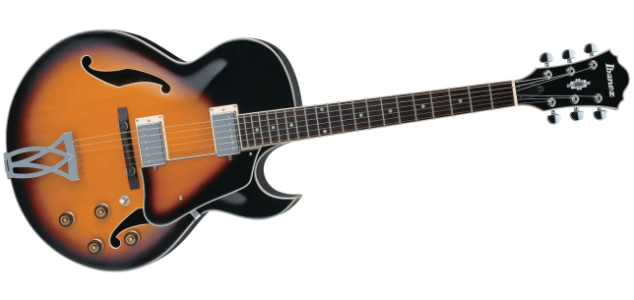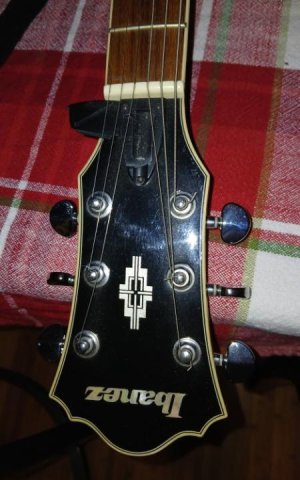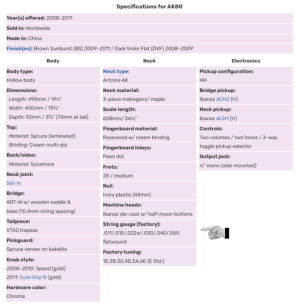Artie
Peaveyologist
Me and a friend were running around, and there was this pawn shop having a sale with free food. (Dawgs and burgers kinda thang.)
He wanted a cheap bass to noodle on. They had a couple, but he didn't like them.
Over in the corner, I spotted this hollow body.
An Ibby AK80. Brown Sunburst. Full hollow body. Not a scratch on it. They made this for three years. 2009 - 2011. This is the newer 2011, that had a couple upgrades. Different headstock logo, and Sure Grip III knobs. She came home with me.
Full binding, front, rear, neck and headstock. But more amazing, the pickguard is laminated spruce, front and rear, on Bakelite, with the same full binding that the rest of the guitar has. The F-holes are huge. Almost full acoustic sound. Easy access if I change the electronics. Which, I love the placement. All in a tight group. Output jack on the lower side, where it belongs.
Bone stock Ibby ACH1/2 pickups, which are simply Artec LPC210's. Not bad, but not exactly "Jazz box". 16.4k bridge with 9.43k neck ceramics. I'll have to think about what to put in here. Seths, Antiquities, Benedettos? Maybe bring my Jazz set over. Not sure how zebra's would look in this box.
Plugged in, at bedroom volume, you get a nice mix of the electric sound and the acoustic sound. Sweetness. I'm lovin' it. But then again, I love every new guitar I get.
And one last oddity: The truss rod cover rotates sideways. You can adjust the truss rod without removing the screws. I don't think this was ever an issue, but they did it. Really strange.
First pic is an internet pic, 'cause my photography skills suck. But mine is identical.
He wanted a cheap bass to noodle on. They had a couple, but he didn't like them.
Over in the corner, I spotted this hollow body.
An Ibby AK80. Brown Sunburst. Full hollow body. Not a scratch on it. They made this for three years. 2009 - 2011. This is the newer 2011, that had a couple upgrades. Different headstock logo, and Sure Grip III knobs. She came home with me.
Full binding, front, rear, neck and headstock. But more amazing, the pickguard is laminated spruce, front and rear, on Bakelite, with the same full binding that the rest of the guitar has. The F-holes are huge. Almost full acoustic sound. Easy access if I change the electronics. Which, I love the placement. All in a tight group. Output jack on the lower side, where it belongs.
Bone stock Ibby ACH1/2 pickups, which are simply Artec LPC210's. Not bad, but not exactly "Jazz box". 16.4k bridge with 9.43k neck ceramics. I'll have to think about what to put in here. Seths, Antiquities, Benedettos? Maybe bring my Jazz set over. Not sure how zebra's would look in this box.
Plugged in, at bedroom volume, you get a nice mix of the electric sound and the acoustic sound. Sweetness. I'm lovin' it. But then again, I love every new guitar I get.
And one last oddity: The truss rod cover rotates sideways. You can adjust the truss rod without removing the screws. I don't think this was ever an issue, but they did it. Really strange.
First pic is an internet pic, 'cause my photography skills suck. But mine is identical.



